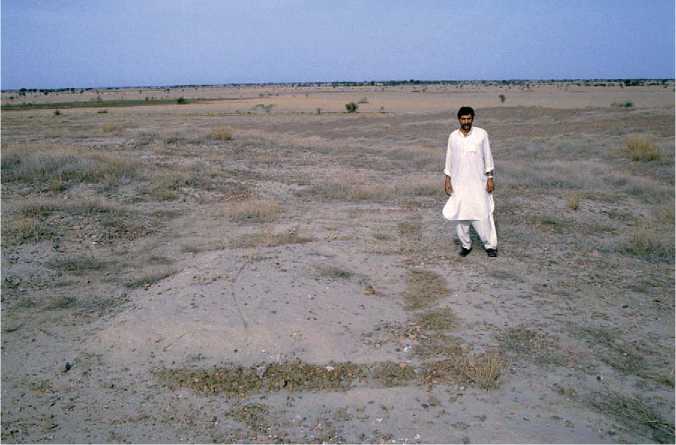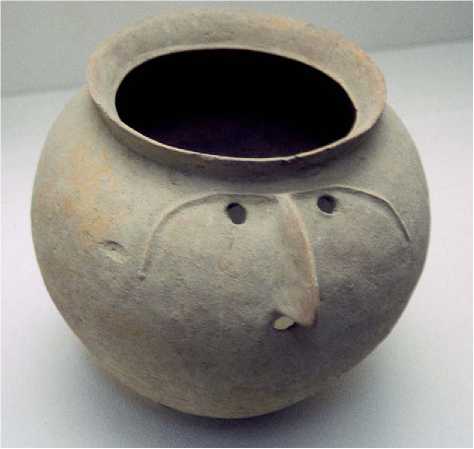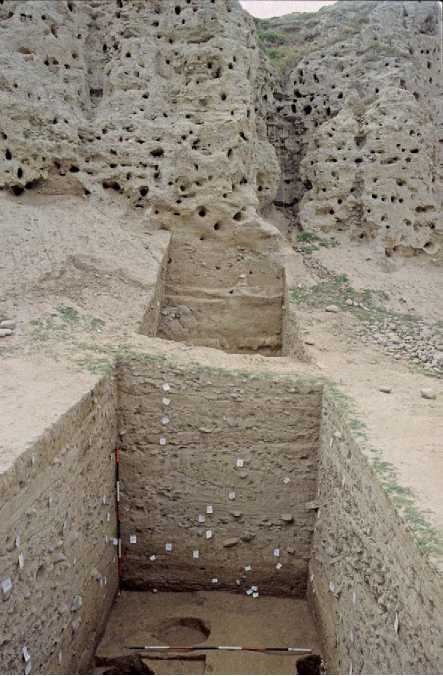The causes of the decline of the Indus Valley cities at the beginning of the second millennium BCE are still debated. Despite this debate, and that over the correct term for its demise, it is widely agreed that this period was one of de-urbanization associated with the loss of long-distance trade, written scripts, weights, measures, and monumental architecture. Traditionally attributed to incursions of Indo-European speakers from Central Asia, it is now recognized that there were many more complex and multifaceted factors involved - not all of which are fully understood, and that concepts of an ‘Aryan invasion’ were more

Figure 9 Exposed house foundation on the surface of Rehman Dheri.
Driven by British imperial motivations than archaeological fact. These points notwithstanding, as the Northwest Frontier and Kashmir were never fully integrated into the Indus urbanized system, they did not suffer from the symptoms of ‘systems collapse’ witnessed in the Indus floodplains; yet the vacuum precipitated the re-emergence of a distinct tradition in the region associated with the adoption of new influences from Western and Central Asia. It is important to note, however, that the region still remained connected with the Punjab, as illustrated by the discovery of ‘Cemetery H’ motifs on sherds from Bir-Kot-ghundai in the Swat Valley.
Gandharan Grave Culture
One of the newly emergent traditions is termed the Gandharan Grave Culture within the Northwest Frontier and the Megalithic within Kashmir, but the sequences oF the two are yet to be fully integrated. It was first identified in Swat by Italian archaeologists and has continued to be studied by the University of Peshawar. A homogenous tradition of burial practices with associated ceramic and artifact assemblages, it appears to have emerged in the upper Indus Valley c. 1700 BCE and then spread across the Valleys of Swat, Dir and Chitral, and into the Vale of Peshawar and survived until the middle of the first millennium BC (Figure 10).
Its most distinctive feature is the stone-sided cists, some of which are surrounded by stone circles. Usually contain one or two inhumations, the body commonly on its side with the legs drawn up and the arms raised and bent. A small number of graves contain cremated remains deposited in an anthropomorphic

Figure 10 Anthropomorphic urn from the Gandharan Grave Culture.
Vessel but almost all are associated with burnished gray - or red-ware vessels and human terracotta figurines, although later examples have more numerous and elaborate grave goods. A number of horse burials have also been recovered from the burials of this tradition as well as items of horse furniture.
Kashmir Valley
Contemporary with this tradition, similar cist burials with associated ‘Megalithic’ architecture have been identified within Kashmir at the sites of Devidhoora and Gwaldam in the Alakananda Valley as well as at
Burzahom and Gufkral. This similarity is also present at Malari where human and horse burials were exposed, the former buried prostrate with their knees flexed, and at Baseri with its cist burials. These common elements, combined with the presence of spouted goblets in both Swat and Kashmir, have led some scholars to advocate an expansion of Gandharan Grave Culture right across the region but others have questioned the contemporaneity of the two.
While cemetery sites are numerous on account of their visible stone remains, there are few contemporary habitation sites. However, evidence from one of the most recently identified, the Bala Hisar of Char-sadda, suggests that communities from the northern valleys had moved southwards to colonize the Vale of Peshawar by c. 1300 BC and were already associated with the manufacture of iron objects. Whether these communities were seasonal, following a transhumant way of life between valleys and plains is unclear with the present data set (Figure 11).
Equally significant is the appearance of related ceramic vessels at Hathial in the Valley of Taxila to the south. When compared with the burnished wares from Charsadda, it becomes clear that a process of convergence was unifying the northern valleys and

Figure 11 View of excavations at the Bala Hisar of Charsadda.
Leading to the establishment of larger settlements on the plains by the beginning of the first millennium BC. This southward movement was soon to be augmented by the introduction of open form vessels from the Ganga Valley to the east, a northward pattern shared with appearance of Painted Gray Ware at Thapli in the Alakananda Valley and Purola in the upper Yamuna Valley (see Asia, South: Ganges Valley). Frequently characterized as a ‘dark age’ between urbanizations, this was clearly a period of steady growth, innovation, and interaction between the Northwest Frontier and Kashmir.




 World History
World History









